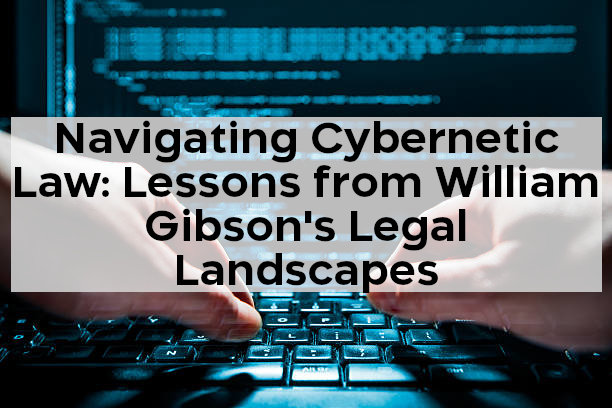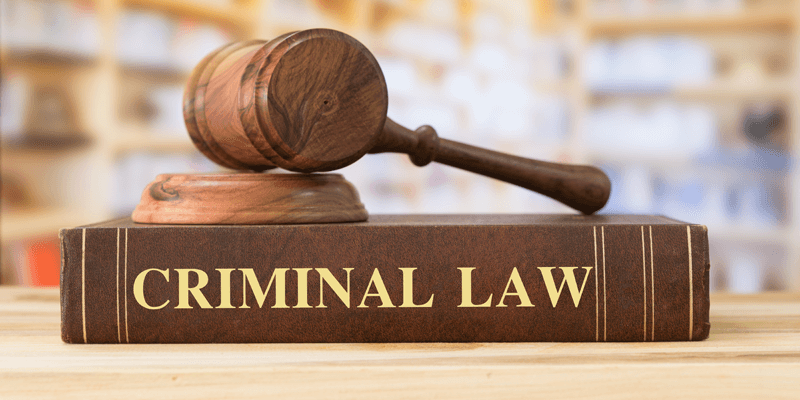DISCLAIMER: Altiorem Legal Services (hereinafter, “Altiorem”) cannot and does not provide legal advice. Altiorem is not a law firm; Altiorem’s staff are not attorneys, cannot act as attorneys, and do not act as attorneys; and any information provided by Altiorem in this article or otherwise is not a substitute for legal advice from an attorney. The information contained in this article should not be construed as legal advice, as it is not intended to be legal advice; the information in this article is provided for educational purposes only. Again, none of the information provided in this article should be construed as legal advice, and nobody should rely on or use the information contained in this article in their legal matters.
INTRODUCTION
William Gibson, a famed author well-known for his pioneering work in the cyberpunk genre, has crafted intricate narratives that depict a technologically advanced future. While his masterpieces such as “Neuromancer,” “Count Zero,” and “Mona Lisa Overdrive” have heavily influenced popular culture, they also offer insightful perspectives on legal theory and practice.
William Gibson, an iconic figure in science fiction, is often hailed as the visionary who first articulated the contours of cyberspace and the information age. His uncanny knack for forecasting technology trends long before their fruition has won him accolades, readers, and a special place in popular culture. His acclaimed works, most notably the Sprawl Trilogy, weave compelling stories around a cyberpunk future teetering on the edge of dystopia.
Yet, the depth of Gibson’s contribution extends beyond just the literary realm. The socio-legal implications of his narratives are profound, presenting a rich tapestry of ideas and predictions that uncannily resonate with current-day realities. His works are not just a prophecy of technology; they also offer a window into the future of law and legal institutions in the face of such technology.
In his cybernetic worlds, one encounters a redefinition of crime, a challenge to the traditional notion of intellectual property, complex considerations around artificial intelligence and personhood, an exploration of privacy in the digital age, and innovative depictions of contract law in a highly advanced society.
In this context, this blog delves into some key themes present in Gibson’s work, exploring their implications for contemporary law. This blog serves as a platform to engage with Gibson’s works from a legal perspective, using his visionary narratives as a lens to examine and critique the landscape of modern law. This intersection of literature, technology, and law offers a fascinating exploration of how the legal systems might evolve to address the imminent complexities presented by a rapidly advancing digital age.
This blog delves into some key themes present in Gibson’s work and their implications on modern law.
CYBERCRIME
The inception of Gibson’s “Cyberspace,” a global network connecting all digital interfaces, provides a fertile ground for novel types of crime. The protagonists in his stories often engage in activities analogous to hacking, data theft, and other forms of cybercrime. This prescience in Gibson’s writing compels one to consider the effectiveness of the current cybercrime laws, many of which struggle to keep pace with the rapid progression of technology. It challenges lawyers and lawmakers to adapt legal frameworks to an ever-evolving digital landscape.
In Gibson’s futuristic landscapes, the digital realm, or “Cyberspace,” is an expansive, interconnected global network that plays host to a unique array of criminal activities. His characters often engage in hacking, data breaches, and digital theft—activities that parallel the modern concerns of cybercrime in our own digital societies.
Gibson’s most famous character, Case from “Neuromancer,” is a prime example. A washed-up computer hacker, Case operates in an underworld filled with data thieves and digital mercenaries, revealing the intricate and compelling forms of cybercrime in Gibson’s universe. This futuristic portrayal underscores the vulnerability of digital systems and the creative ways criminals could exploit them.
The prescient nature of Gibson’s writing is underscored by the current struggle of law enforcement and legal systems to combat cybercrime effectively. As technology continues to evolve at an unprecedented rate, the laws designed to protect against cybercrime often lag behind. This predicament challenges lawyers and lawmakers to continually update legal frameworks to match the pace of technological advancement.
Furthermore, Gibson’s work also invites a rethinking of jurisdictional boundaries in law enforcement. In a digital world where crime can be committed across physical borders with a few keystrokes, the traditional jurisdictional approach of law enforcement seems outdated. His work highlights the need for global cooperation and the harmonization of legal standards to tackle cybercrime efficiently.
Lastly, Gibson’s exploration of cybercrime forces one to examine the ethics and laws around digital punishment. If peoples’ identities and lives are increasingly digital, as Gibson envisages, what does punishment look like in that context? It compels one to question whether traditional notions of punishment and restitution are adequate for crimes committed in cyberspace.
By crafting compelling narratives around cybercrime, Gibson urges one to rethink societies’ legal systems, prompting one to be proactive rather than reactive and thereby fostering a more resilient digital society.
INTELLECTUAL PROPERTY
Gibson’s works frequently involve the theft or manipulation of data and digital resources, which bear similarities to modern concerns about intellectual property rights in the digital age. His narrative raises questions about the boundaries of ownership, the nature of intellectual property, and the ethics surrounding data privacy and digital rights. As humanity continues to advance technologically, these themes serve as cautionary tales, highlighting the need for robust legal protections for digital assets.
William Gibson’s cyberpunk universe frequently grapples with the concepts of data ownership, manipulation, and intellectual property rights. In his world, the very notion of what constitutes “property” is stretched beyond the physical. Data, ideas, and digital resources—intangible yet invaluable assets—are frequently the targets of theft or manipulation.
The character of Bobby Newmark (also known as “Count Zero”), a novice hacker who stumbles upon an incredibly valuable piece of software, invites one to consider the commodification and ownership of data. How does society assign value to such digital assets? Who can claim ownership over them, especially in a world where data can be easily replicated and disseminated across the globe?
Gibson’s work brings to light the challenges surrounding the protection of intellectual property in the digital age. It forces one to consider whether current laws—designed largely around physical property and established long before the digital revolution—are sufficient and appropriate for the protection of digital assets. As data becomes an increasingly valuable commodity, these questions become more pressing.
Gibson also prompts one to consider the extent of ownership over data. In an age where data is constantly generated, collected, and analyzed, the distinction between public and private data often blurs. Should individuals have the right to control or profit from the data they generate? Or do companies that collect and analyze the data have some rights to it?
Additionally, Gibson’s narratives highlight the ethical considerations around data privacy and digital rights. How does one balance the demand for openness and accessibility in the digital sphere with the need to protect proprietary information and individual privacy?
These intellectual property dilemmas in Gibson’s work serve as cautionary tales, accentuating the importance of updating legal frameworks to better account for the unique challenges of the digital age. They remind one of the complexities of crafting laws for a rapidly changing digital environment and the need for a dynamic and adaptable approach to legislation.
ARTIFICIAL INTELLIGENCE
Gibson’s exploration of artificial intelligence (AI)—sentient, independent, and often powerful—provides interesting insights into legal personhood and liability. His AI characters, sometimes more intelligent than their human counterparts, evoke considerations of whether AI should have rights or legal status, a debate that resonates in today’s legal arenas. Moreover, it raises questions about liability if an AI were to commit a crime or cause harm.
In Gibson’s work, AI is more than just a tool or technological advancement—it represents a transformative force that challenges one’s understanding of consciousness, agency, and legal responsibility. His AIs are sentient, independent entities, often with motivations and capacities surpassing those of human characters.
Wintermute and Neuromancer, the AI entities from Gibson’s novel “Neuromancer,” present fascinating implications for legal theory. They are highly advanced, autonomous, and capable of complex decision-making, raising questions around the legal status and rights of AI. If an AI exhibits characteristics of consciousness and independent thought, as Gibson’s AIs do, should it be granted legal personhood or rights akin to those of human beings?
This debate mirrors contemporary discussions in legal and academic circles about the potential need to extend certain legal protections to AI. As AI continues to evolve, the legal framework must address whether and to what extent it should be treated similarly to humans under the law. Gibson’s exploration of AI underscores this need for a reevaluation of society’s legal definitions of personhood and responsibility.
Moreover, Gibson’s AI characters also invite considerations of liability. Who bears legal responsibility for those actions if an AI can act independently and potentially cause harm? Is it the creators, the owners, or the AI itself? These questions have far-reaching implications for criminal, tort, and contract law, among others.
Additionally, Gibson’s portrayal of AI also questions the ethics of creating sentient digital entities. If an AI has consciousness, can it experience suffering or exploitation? And if so, should laws be put in place to prevent such potential harm?
Through his intricate portrayals of AI, Gibson challenges one to grapple with these complex legal and ethical considerations. His work is a timely reminder that as technology advances, legal systems must evolve alongside it, striving to balance progress with ethical and societal considerations.
PRIVACY
In Gibson’s world, the concept of privacy is often stretched thin, with pervasive surveillance and data mining commonplace. His characters live in societies where their digital lives are persistently monitored and manipulated. In this world where data is a vital commodity, Gibson’s work echoes contemporary debates on the balance between security, personal privacy, and corporate interests.
In the vast interconnected landscapes of Gibson’s cybernetic world, the concept of privacy is continuously tested. His societies often depict a future where personal information is persistently accessible, monitored, and exploited, whether by powerful corporations, shadowy entities, or cyber-criminals.
Characters in Gibson’s narratives navigate a world saturated with surveillance and data mining. The omnipresence of digital surveillance blurs the line between public and private, eroding traditional notions of privacy. Such portrayals resonate powerfully with modern society’s struggles to protect privacy in the face of pervasive data collection and surveillance practices.
In this current world, where data is a powerful commodity, Gibson’s narratives serve as a potent warning about the potential loss of personal privacy. His work highlights the tension between the value of data for businesses and governments and individuals’ right to privacy. It underlines the urgent need for legal frameworks that can effectively balance these interests, ensuring robust data protection without stifling technological progress.
Gibson’s work also prompts one to consider individuals’ consent and control over their personal data. How would society define and enforce digital rights in an age where personal data can be collected, analyzed, and sold often without explicit consent? His narratives stress the importance of transparency and accountability in data collection practices and highlight the potential risks of unchecked data commodification.
Furthermore, Gibson’s stories urge one to consider the international scope of privacy. In a world as interconnected as Gibson’s, data privacy and protection cannot be confined within national boundaries. His work emphasizes the need for global standards and cross-border cooperation to safeguard privacy.
In essence, Gibson’s work provides a valuable lens through which to scrutinize society’s current privacy laws. By extrapolating current trends to their potential dystopian conclusions, he urges one to address the challenges of today to prevent the potential privacy infringements of tomorrow.
CONTRACT LAW
Gibson’s works also touch on interesting aspects of contract law. His characters often engage in complex agreements, some involving AI entities or corporate bodies with vast resources. Such interactions underline the importance of clear, enforceable contracts and the power dynamics that exist within legal agreements, a reality that is increasingly relevant in the present technology-driven society.
Gibson’s narratives, complex as they are, delve into nuanced aspects of contract law. Characters often enter into intricate agreements that touch upon several contemporary legal issues. These contracts are not always between humans but can involve artificial intelligences, corporate bodies, and even state-like entities.
In “Neuromancer,” the protagonist, Case, is essentially under a contract with a powerful AI, Wintermute. This agreement, layered with elements of coercion and manipulation, blurs the line between voluntary consent and induced compliance, raising questions about the fundamental tenets of contract law, such as free will and informed consent.
Gibson’s portrayal of contract law also underscores the power dynamics inherent in contractual relationships. Powerful entities, be they AIs or mega-corporations, often hold a disproportionate amount of bargaining power, leading to potentially exploitative agreements. This power imbalance reflects the real-world need for legal protections to prevent undue influence and unconscionable agreements.
Furthermore, Gibson’s works evoke questions about the enforceability of contracts in a technologically advanced, global society. How would society ensure the enforcement of agreements when parties might span different jurisdictions or even states of being (e.g., AI versus human)? Gibson’s narratives suggest the need for an adaptable, globally-minded approach to contract enforcement.
The concept of “smart contracts” can also be gleaned from Gibson’s works. These contracts are embedded in computer code and executed automatically once certain pre-determined conditions are met. In a world where transactions increasingly occur in the digital space, the shift from traditional paper contracts to programmable, self-executing agreements could revolutionize the way society views contract law.
By highlighting these aspects, Gibson nudges one to confront the limitations and potential pitfalls of society’s current contract laws. His works underscore the need for a flexible, forward-thinking legal approach that can handle the complexities of an increasingly interconnected and digital world. His insights remind one that, in the face of rapid technological advancement, the law must adapt and evolve.
CONCLUSION
While Gibson’s work may be fiction, the legal issues he presents are very real. His dystopian narratives serve as a mirror to society, reflecting current and future legal dilemmas that the rapid progression of technology presents. By exploring Gibson’s “legal landscapes,” one can better understand and prepare for the challenges that lie ahead in this increasingly digital world.
Gibson’s stories also underscore a truth that applies to law as much as it does to life: the only constant is change. As society navigates the evolving techno-legal landscape, it can look to Gibson’s vision as a guide, using his imagined challenges as a tool to better understand and address society’s real ones. By doing so, society can hope to create a legal system that, much like Gibson’s prose, is ready to meet the future head-on.
William Gibson’s cyberpunk narratives have proven themselves to be more than just an enthralling exploration of a high-tech, dystopian future. These works hold a mirror to the present, challenging one to interrogate the adequacy and adaptability of society’s current legal frameworks in light of rapid technological advancements. Gibson’s stories underscore the necessity for a proactive, flexible legal system capable of addressing the complex socio-legal implications that come with the digital age.
Through Gibson’s intricate portrayal of cybercrime, he unveils the escalating challenges that legal institutions face in their pursuit of justice within the digital landscape. His narratives accentuate the need for global cooperation, timely legislation, and a rethink of traditional law enforcement approaches to effectively combat this new breed of crime. Gibson’s depictions prompt one to revisit and possibly redefine society’s legal understanding of punishment and restitution in the context of the cyber realm.
Gibson’s exploration of intellectual property rights in a future permeated by data manipulation and theft draws attention to the limitations of current legal safeguards designed for physical property. Gibson’s stories press one to reassess how society attributes value to digital assets, question the extent of ownership over personal data, and consider the ethical balance between openness, privacy, and proprietary rights.
In his depictions of sentient AI, Gibson pushes the boundaries of legal personhood and responsibility, provoking discussions around rights, liability, and the ethical implications of sentient digital entities. These narratives draw one’s attention to the pressing need for society’s legal definitions to evolve in step with technological progress.
Gibson’s evocative portrayals of pervasive surveillance and data commodification are potent warnings about the potential erosion of personal privacy. His works highlight the pressing need for robust data protection laws, transparency in data collection practices, and international cooperation in safeguarding privacy rights.
Finally, Gibson’s works illuminate the complexities of contract law in an advanced digital age. His narratives call for reevaluating traditional contract doctrines such as free will and informed consent, urging one to address power imbalances within contractual relationships and consider the potential of programmable, self-executing agreements.
In conclusion, William Gibson’s work is a clarion call for the legal world, urging one to meet the challenges of the digital age head-on. Though set in a futuristic landscape, his prophetic narratives hold profound implications for the here and now. They prompt one to confront the limitations of society’s current legal paradigms, forcing one to envision how law can evolve to navigate the impending complexities of an increasingly digital world. Through his works, Gibson challenges one to become architects of a flexible, just, and future-ready legal system capable of keeping pace with the relentless march of technological advancement.
CONTACT US TODAY!
Do you need help with cybercrime or other technology-related legal issues? Let Altiorem help you today with affordable, top-quality legal services.
Expertise. We are knowledgeable, skilled, and experienced in cyber law and in drafting all manner of legal documents, such as briefs, pleadings, motions, memoranda, letters, contracts, etc. If you need a top-quality, professional, excellently written, well-researched, and compelling legal document drafted, then look no further!
Quality. We produce top-quality, properly written legal documents with impeccable grammar, punctuation, spelling, structure, flow, information, compelling legal arguments, and persuasive legal conclusions. You can see the quality of our work on our work samples page, where you can peruse and evaluate our writing, as well as our other blog posts.
Experience. Our paralegals are highly experienced in working with attorneys, other paralegals, and court personnel.
Customer Care. Navigating the Utah legal system can be daunting and confusing. Let Altiorem relieve your stress and be your guide. Altiorem has a team of professional paralegals ready to work for you. We want to give you the best chance at getting an outcome for your case that you will be happy with. We are happy to receive documents via email from you, speak with you on the phone, look through court files, or even translate documents (English / Spanish)!
Accessible. If you are interested in retaining our services, we can be contacted at (801) 855-6541 (text or call) and at altiorem@altioremlegalservices.com. If you have a project in mind that you would like us to work on, please click here to send us a project request and get a quote. Alternatively, you can send us an email detailing the work you need to be performed, and a real person will respond promptly.
Thank you for your attention and consideration.



